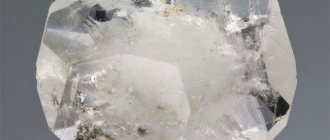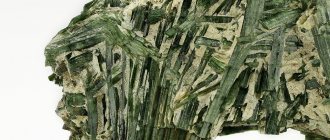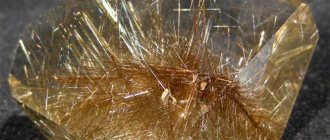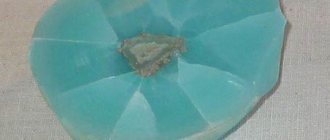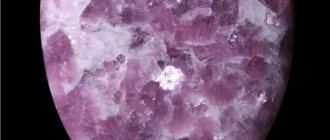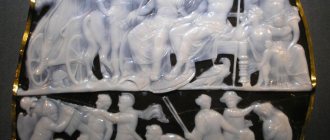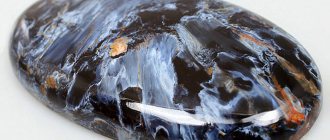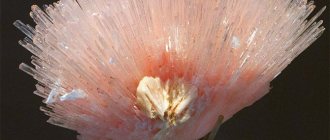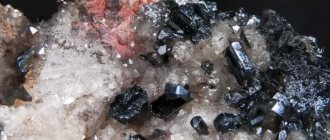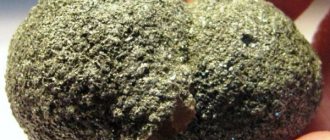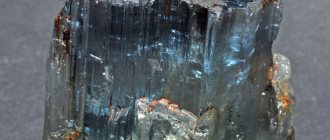| Category | Oxides (minerals) |
| Title in English | Carneol |
| Formula | SiO2 |
| Group | Chalcedony group |
| Color | Pink, Brown-red |
| Stroke color | White |
| Shine | Wax |
| Transparency | Translucent in thin sections |
| singonia | Trigonal |
| Hardness | 6,5 — 7 |
| Cleavage | Absent |
| Density, g/cm³ | 2,58 — 2,64 |
| Kink | Uneven |
| origin of name | Carnelian gets its name from the Latin word cornus. In science, this term was originally used only to refer to dogwood. Since the color of the stone resembles the fruits of a shrub plant, the English name Carnelian was formed. This is where the Russian version of the name came from - carnelian. Also, there is a name carnelian. |
Several thousand years ago, the ancient Egyptians already knew the mineral carnelian. In those days, it served as material for various crafts for the tombs of the pharaohs. In addition, this precious stone was known and widely used by the Greeks, Romans, and Easterners. In Rus', carnelian was known as “carnelian”, that is, a stone that resembles the heart or pleases the heart; it was used mostly for religious purposes. Today, carnelian remains popular among jewelers and gemstone connoisseurs.
Carnelian deposits
Carnelian intergrowths are usually of volcanic and sedimentary origin. The mineral is often found in porphyritic and basaltic rocks, or together with limonites and quartz. Carnelian is mined mainly near volcanoes and off the coast of various bodies of water. Beautiful large specimens are found in countries such as India, Brazil, Uruguay and the USA. Russia, Bulgaria, Mongolia, Australia, Madagascar and Sri Lanka are also known for individual deposits.
Place of Birth
The stone is mainly found in volcanic rocks. The mineral fills the cracks. In geology they are called geodes and nodules. Carnelian can mainly be found in porphyrites, basalts and traps. There are other rocks where this gem is not so much a natural inclusion, but an integral component. These rocks include opoka and jasper.
Carnelian is found not only in sedimentary rocks. It can be seen in mollusk shells and loose rocks, such as pebbles. This is where the broken particles end up. Carnelian has satellite stones that help geologists find deposits of Carnelian itself. This can be limonite, quartz and other carbonates.
Gem deposits are located near reservoirs and volcanoes. Places where the mineral is mined: India, Mongolia, Bulgaria, Brazil, Madagascar, Germany, the Arabian Peninsula. Gems are exported to other countries from Russia, Sri Lanka, Australia, the USA and Uruguay.
History of carnelian
— Advertising —
Carnelian is a variety of chalcedony. It is colored rich red, brown or red-brown. The name of the stone is translated from Latin as “flesh” and indicates its color. Another ancient name for carnelian carnelian was used in Kievan Rus.
According to archaeological data, carnelian has been known to man since Paleolithic times, when labor items, piercing and cutting tools were made from it. The Egyptians made scarabs from this stone, and the noble inhabitants of Babylon made seals. Carnelian amulets and talismans have been popular at all times and are found during excavations in various regions of our planet.
Areas of application
Jewelers love this natural stone, as it makes excellent jewelry at a reasonable cost. Unique crafts are also made from it: boxes, wall mosaics, mirror frames, and interior elements are inlaid with it. This mineral is usually cut into an oval or circle shape. Jewelry with carnelian inserts is much cheaper than with other stones, although its appearance is in no way comparable to them, and even surpasses some.
Products containing this gemstone should be stored separately from other jewelry and not exposed to bright sunlight or excessive humidity. If items become dusty, carefully wipe them with a damp cloth without using abrasives.
Physicochemical characteristics of carnelian
In terms of its chemical composition, carnelian is a silicate, the red tint of which is associated with the presence of impurities of iron compounds.
Depending on the amount of the latter, the color palette of the mineral varies from brown to orange and yellow. The hardness of carnelian is 7 on the Mohs scale, the mineral is highly durable and even leaves scratches on glass. The density is 2.6 g/cm3. There is no cleavage, the fracture is sharp and uneven.
— Advertising —
Carnelian differs from quartz in its characteristic waxy luster. The mineral is opaque, sometimes translucent. Dissolves only in hydrochloric acid.
Colors and varieties of carnelian stone
The color range of carnelian varies between light yellow and dark brown shades. In nature, there are specimens that have a rainbow structure: transparent layers are adjacent to dull white ones. The degree of coloring affects the transparency of the gem.
Carnelian is considered a summer (July) mineral. This is due to the fact that it looks like a summer sunset. One gets the feeling that this amazing stone managed to absorb all the shades of the sunset. It absorbs various tones from honey to dark. Some stones are a deep burgundy color, reminiscent of blood. There is an opinion that the shades of the mineral depend on how intense the sun's rays hit the earth's fault in which its deposits are concentrated.
Types of stone also include:
- Sardonyx. The shades of the mineral range from brown to brown.
- Lincurium. Tones vary between yellow and warm orange.
Types of carnelian
According to the color palette, several varieties of gems are distinguished:
- carnelian itself is colored blood red;
- sardonyx - stones painted in shades of brown and brown;
- lincurium - distinguished by warm yellow-orange flowers.
The magical properties of carnelian
Carnelian is a talisman for love, fidelity, happiness and mutual understanding in the family.
As a fairly strong amulet, it protects the house from negative energy, becomes a protector against treason, betrayal, quarrels, and brings harmony and prosperity to the family. Moreover, it is believed that carnelian is able to ward off even the most terrible diseases and bad events from its owner. In business, the stone promotes good luck, develops entrepreneurship and communication skills, which is also good for public people.
Interestingly, carnelian affects different sexes differently depending on its color. Light red and peach patterns are more suitable for women. For men, dark red and brown carnelians are recommended.
Medicinal properties of carnelian
In lithotherapy, carnelian powder and medicinal ointments, solid crystals and thin plates are used.
In Europe, mineral powder was added to wine for migraines, to normalize blood pressure, improve blood flow and prevent hearing loss. In addition, it was used to treat purulent wounds.
Various decorations with carnelian have specific effects on the human body. Thus, rings have a positive effect on the functioning of the heart. Earrings help with migraines, relieve fatigue and stress. Bracelets improve metabolism and generally normalize the functioning of the gastrointestinal tract. Applications with carnelian are used to treat diseases of the genitourinary system. And simply looking at this beautiful mineral helps to calm and stabilize your emotional state.
Carnelian stone in the history and culture of peoples
Carnelian stone photo
A historical excursion reveals interesting facts: the stone was in use already in the Paleolithic era. The most interesting finds from the mineral are primitive household tools.
Later, the gem came into the culture of Ancient Egypt: they began to cut stone scarabs from carnelian. The magical properties of the mineral are also confirmed by the ancient Egyptian “Book of the Dead”. It describes the burial procedure, which includes the obligatory placement of carnelian - magical armor for the deceased - in the tomb.
The Babylonians appreciated the strength and practicality of the mineral to a greater extent. It was used to make gem seals for noble people. But the richest variety of material artifacts from the gem is provided by the Slavic culture, where its absolute identification with carnelian is observed.
Ancient jewelry, ritual objects, and various amulets made of carnelian were extremely popular among the Slavic peoples. This is confirmed by archaeological finds, the most interesting of which were found in the Urals. For example, arrowheads dating back to the Neolithic and Bronze Ages from a cave on Lake Shaitanskoye.
At a Mesolithic site on Lake Ayatskoye, a craft flint made from this gem was found. Scientists were particularly interested in two knives from excavations near Lake Shaitanskoye. One knife-like plate is made of dark red translucent carnelian, the second is made of two-color chalcedony stone.
The blade is made of orange translucent carnelian, and the tip is made of red-brown sarder. Additional research showed that this combination of flowers and gems had a sacred meaning.
Applications for carnelian
For many centuries and even millennia in a row, carnelian has been used in the crafts and jewelry industry.
As a very hard and durable mineral, it is excellent for making frames for mirrors, boxes, souvenir balls, and elements of wall mosaics. Processed large carnelian crystals make excellent interior decorations. In jewelry, the stone is cabochon cut into a round or oval shape, and then used in a wide variety of jewelry: rings and pendants, brooches, bracelets and earrings, beads and necklaces.
How to distinguish real carnelian from a fake
Imitations of carnelian are made from colorless or gray-colored chalcedony, which is colored using iron nitrates.
This effect is easy to distinguish even by the appearance of the stone and it is clearly visible on the fault. In addition, similar samples are obtained by slow calcination of silicas over fire. Natural carnelian can be distinguished from fakes by the so-called internal “cloudiness”, which is caused by the uneven distribution of impurities in the composition of the natural stone.
Stone care
Carnelian does not require special care; to preserve its appearance, it is enough to follow a few rules:
- store separately from other minerals, using a box with soft upholstery;
- protect from impacts, falls and other mechanical impacts;
- Clean with warm soapy water, do not use products containing abrasives or acidic compounds.
Periodically, the gem must be placed in the direct rays of the sun so that it is charged with their “warm” energy.
Carnelian and zodiac sign
Carnelian goes well with Leo and Cancer, and becomes a faithful assistant for them.
The mineral helps Leos achieve success in career matters, enhances leadership qualities, increases efficiency and communication skills. Charms with carnelians protect Leo from suspiciousness and protect against failure. As for Cancers, carnelian helps them gain self-confidence and sociability, brings optimism and harmony, and helps fight melancholic and depressive states. Talismans with carnelian are not recommended for Scorpios, Aries and Sagittarius. Representatives of other zodiac signs can use them as needed.
Interesting facts about carnelian
- In Ancient Egypt, carnelian was a symbol of the goddess Isis, woman and mother. And the ancient Greeks associated Eros with him. During the Middle Ages, the bright color of the mineral associated it with the martyr Bartholomew. But nevertheless, the theme of the heart and love affairs later returned to this wonderful stone, and today it is considered one of the best helpers for lovers.
- One of the Muslim legends says that the Prophet Muhammad had a carnelian ring on his right hand, which he also used as a seal.
- The most famous carnelian product is an octagonal seal with the biblical legend of Abraham embossed on it. Its owner was Napoleon III, he wore it on a watch chain and left it as an inheritance to his son. After the death of the latter, the trace of the seal was lost.
How to wear it correctly
When choosing jewelry with carnelian, it is recommended to adhere to the following rules for wearing it:
- do not wear all types of massive jewelry at once, so as not to make your image rude and vulgar;
- leave items with large stones for parties and special events, while jewelry with small inserts can be used to complement your everyday look;
- pure carnelian is most suitable for brown-eyed women with red or dark hair, lincurium - for blondes;
- to maintain energy balance, it is advisable to wear carnelian rings on all fingers except the ring finger;
- The optimal metal for setting this gem is bronze and silver.
